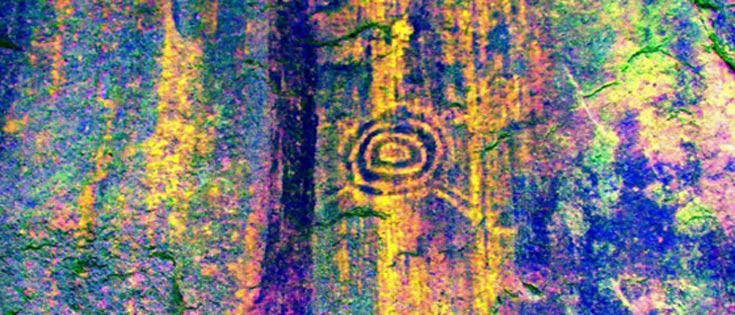New Rock Paintings Discovered in Machu Picchu
More than 600 years ago the ancient Incas built a village in the Andes on the rocky outcrop that links the mountains Machu Picchu and Huayna Picchu, at an altitude of 2,490 meters (8169.29 ft.) It is a town whose original name would have been Llaqtapata, which is known today as Machu Picchu.
Less than a month ago, Ancient Origins reported the latest discovery found on the walls of natural stone at the incomparable Machu Picchu: rock paintings that could mean an unexpected turn in the knowledge of Machu Picchu's history. Now, four weeks later, experts have been able to confirm that the historic sanctuary of Machu Picchu, nestled between towering Andean fog covered peaks almost all year, hides numerous examples of rock art that have gone unnoticed for decades.

Digitally enhanced photo in which Andean camelids rectangular bodies are represented. (Fernando Astete/National Geographic)
According to data published by National Geographic, the digital image analysis has revealed different representations, both figurative and abstract, which are hardly noticeable at first glance. The researchers of the Cultural Department of Cusco have discovered various simple representations of Andean camelids to more complex pictograms such as concentric circles and geometric figures that have not yet been deciphered. The date of their creation is also unknown, as researchers still do not know whether these findings are of an Inca or pre-Inca time period.
The new samples of rock art are found both painted and engraved on the surface of the rock and are mainly concentrated in two sectors of the magnificent Inca city, areas known as Paraguachayoq and Inkaterra.
- New discoveries confirm astronomical knowledge of Incas at Machu Picchu
- Choquequirao: Sister Site of Machu Picchu still holds Hidden Secrets
- New section of Inca road leading to Machu Picchu discovered

Sacred rock at Machu Picchu with traces of rock art that are indistinguishable to the naked eye. (National Geographic/Fernando Astete)
"A detailed study will allow us to determine the cultural sequence of the llaqta of Machu Picchu. For now, we can only put forward that the art represents human activities related to the sacred environment of Machu Picchu. On the Rock of Snakes, for example, there is evidence of a high number of toqos [small holes] shaped like snakes and lines. Similar images are also seen in a segment of the Intipunku road, which provides access to Machu Picchu" Fernando Astete, director of the National Archaeological Park of Machu Picchu, said in statements collected by National Geographic.
In the Pachamama sector, where there is a natural cave, the archaeologists have registered more than six graphic groups, including pictographs and graffiti "with various motifs formed by black figures and geometric curvilinear designs," according to Astete.

Rectangle with triangular sections painted inside. (National Geographic/Fernando Astete)
At the Paraguachayoq sector they have been discovered an unspecified number of pictographs with zoomorphic designs, namely rectangular Andean camelids whose bodies differ somewhat. Finally, in the sector Inkaterra they have observed a set of abstract- geometric pictographs: "Whose main motif is concentric circles with lines coming from it, while the most notable is represented by a rectangle with quadrangular sections painted inside and superimposed on other quadrangular and linear motifs," Fernando Astete explained.

Petroglyph engraved on a rock in the form of a star. (Fernando Astete/National Geographic)
Top image: Photograph of the main motif for the Inkaterra sector consisting of concentric circles with outgoing lines. (National Geographic)
By Mariló T. A.
This article was first published in Spanish at https://www.ancient-origins.es and has been translated with permission.




















Comments
Found in the Urantia Book....
93:3.3 The symbol of the three concentric circles, which Melchizedek adopted as the insignia of his bestowal, a majority of the people interpreted as standing for the three kingdoms of men, angels, and God. And they were allowed to continue in that belief; very few of his followers ever knew that these three circles were emblematic of the infinity, eternity, and universality of the Paradise Trinity of divine maintenance and direction; even Abraham rather regarded this symbol as standing for the three Most Highs of Edentia, as he had been instructed that the three Most Highs functioned as one. To the extent that Melchizedek taught the Trinity concept symbolized in his insignia, he usually associated it with the three Vorondadek rulers of the constellation of Norlatiadek.
53:5.4 . . . in the presence of the forgathered hosts of loyal personalities, he displayed the banner of Michael, the material emblem of the Trinity government of all creation, the three azure blue concentric circles on a white background.